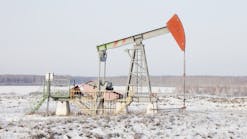US, Canada jointly release crude-by-rail transportation rules
The US and Canada simultaneously issued new regulations governing transportation of crude oil and other hazardous materials by rail.
“Our close collaboration with Canada on new tank car standards is recognition that the trains moving unprecedented amounts of crude by rail are not US or Canadian tank cars—they are part of a North American fleet, and a shared safety challenge,” US Transportation Sec. Anthony Foxx said at a May 1 presentation at DOT headquarters.
Canadian Minister of Transport Lisa Raitt, who also attended the ceremony, said it is critical that the requirements apply equally to tank cars in both countries because they cross the Canadian-US border daily. “That is why the open and transparent process that was followed to jointly develop these regulations included consultations with government and industry stakeholders on both sides of our border,” she said.
DOT said the final US rule, which its Pipeline and Hazardous Materials Safety Administration and Federal Railroad Administration jointly developed in coordination with Canada:
• Unveils an enhanced tank-car standard and an aggressive, risk-based retrofitting schedule for older tank cars carrying crude oil and ethanol.
• Requires a braking standard for certain trains that will improve safety by potentially reducing an accident’s severity, and the “pile-up effect.”
• Designates operational protocols for trains transporting large volumes of flammable liquids, such as routing requirements, speed restrictions, and information for local government agencies.
• Provides sampling and testing requirements to improve classification of energy products placed into transport.
Raitt said the new regulations will require tank-car manufacturers in both countries to build a new, safer tank car called the TC or DOT 117. Its design will include thicker steel shells and heads to improve puncture resistance and structural strength; shields to protect the car’s head from being punctured; thermal protection and a jacket to better withstand heat from fire; protective covers over valves and accessories on top of a tank car; and stronger bottom outlet valves to withstand derailments and prevent leaks.
“Second, these regulations provide new performance-based standards to build the TC and DOT-117 models and establish the retrofit schedule for older tank cars,” Raitt said. “And finally, the regulations stipulate when Canada and [US] rail operators must phase out the use of DOT-111 and CPC 1232 tank cars.”
Both countries’ top transportation leaders noted that other departments and agencies in their governments also have been working on finding ways to improve the transportation of crude and other hazardous materials by rail.
Initial responses
Petroleum and railroad industry association officials immediately welcomed the new rules, but expressed concerns.
“As we review these rules, the key question is whether science and data show each change will make a meaningful improvement to safety,” American Petroleum Institute Pres. Jack N. Gerard said. “A thoughtful, comprehensive, and data-driven safety approach is critical to improving on the 99.997% safety record of freight rail to reach our goal of zero accidents.”
Inclusion of a requirement for electronically controlled pneumatic (ECP) brakes will add to the artificial constraints created by a timeline for retrofitting the existing tank car fleet that does not fully account for limited shop capacity available to complete the work, Gerard warned. “The safety impact of ECP brakes is marginal at best,” he said. “It is concerning that regulators did not select one of several alternative braking technologies that have much clearer benefits for safety.”
The American Fuel & Petrochemical Manufacturers is reviewing DOT’s tank-car regulations and expects to have further comments, AFPM Executive Vice-Pres. Brendan Williams said.
“We intend to work with DOT to implement today’s mitigation-focused rulemaking to the greatest extent possible, but caution that this aggressive retrofit schedule is unrealistic and may be disruptive to transporting crude oil to markets across the country,” Williams said. “Now that tank car specifications have been addressed, AFPM suggests that it is long overdue for DOT to show similar concern for the root causes of train derailments: track integrity and human error.”
The Association of American Railroads also welcomed the new tank car rules, but expressed disappointment that they require either using ECP brakes or a 30 mph speed limit. “DOT couldn’t make a safety case for ECP, but forged ahead anyhow,” AAR Pres. Edward R. Hamberger said. “This is an imprudent decision made without supporting data or analysis. I have a hard time believing the determination to impose ECP brakes is anything but a rash rush to judgment.”
The new US and Canadian railroad hazardous material transportation safety requirements were announced a day after seven US Senate Democrats introduced a measure aimed at accelerating phase-outs of older tank cars and replacing them with newer models (OGJ Online, May 1, 2015).
Contact Nick Snow at [email protected].

Nick Snow
NICK SNOW covered oil and gas in Washington for more than 30 years. He worked in several capacities for The Oil Daily and was founding editor of Petroleum Finance Week before joining OGJ as its Washington correspondent in September 2005 and becoming its full-time Washington editor in October 2007. He retired from OGJ in January 2020.


